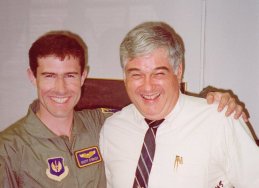
after Scott's recovery.
Life Science Equipment Laboratory picture
|
One of the most knowlegeable and helpful men in the history of egress, Mike Grost,
passed away Sunday November 28, 1999. He was a tremendous help to many people
in the egress community, and his work with Martin-Baker Aircraft and the United
States Air Force was certain to have saved many lives.
Skip Goodman has provided a short synopsis of Mr. Grost's life, see below. .
According to Mr. Grost's wishes, any donations should be made to:
|
|
The National League of Families of American Prisoners of War and Missing in Action in Southeast Asia 1001 Connecticut Ave NW
|
It is with great sorrow that I announce the untimely death of Mr Michael R. Grost, Chief Scientist and head of the Life Sciences Equipment Laboratory.
 |
|
Mike Grost (right) and CAPT Scott O'Grady after Scott's recovery. Life Science Equipment Laboratory picture |
In 1966, following Regular RAF service, he was employed by the Martin-Baker Aircraft Company Ltd. (MBA), in England, which is the world's largest manufacturer of aircraft escape systems, as a Service Department Engineer assigned to: aircraft escape statistical analysis, instructional, and aircraft mishap investigation duties. Between 1969-1976 he acted as Company Field Engineer to the USAF Pacific Air Forces (PACAF), assigned to HQ 13AF Operations at Clark AB, Republic of the Philippines. During the PACAF tenure he covered the South East Asia (S.E.A.) war theater, acting as a technical advisor on the F-4 Phantom aircraft escape system, while also providing lateral support on: other MBA equipment being used by the US Navy, USMC, and US Army; egress systems maintenance guidance; (combat) aircrew escape and survival training; and aircraft mishap investigation work. In 1976 he was reassigned to the United States to become Company Field Engineer to the USAF on a worldwide basis, at the San Antonio Air Logistics Center, Texas. In 1983 he formed the Life Support Equipment Investigation Laboratory, which was a unique facility within the Department of Defense, to conduct specialized studies on life sciences equipment, as exemplified by: flight or protective clothing and uniform ensembles, ejection seats and parachutes, life raft and life preserver systems, signaling devices, and other items used for emergency or combat theater escape, evasion and rescue. Other Laboratory functions encompassed the technical and scientific support of aircraft Mishap Investigation Boards, and provision of specialized training in life sciences equipment investigation to: USAF Life Support and Aeromedical Officers, selected enlisted personnel, Federal employees, and representatives from other US Military and allied foreign nations.
With sponsorship by the USAF in 1990 he was granted Permanent Residency in the United States of America, under the Third Preference category of aliens with exceptional ability in the field of sciences, and employed by the Federal Government as a Physical Scientist. In 1993 the Joint Chiefs of Staff directed that the (now renamed) Life Sciences Equipment Laboratory support the Joint Task Force-Full Accounting, in its mission to resolve the status of those who remain unaccounted for or Missing In Action (MIA) from the S.E.A. conflict, which led to creation of a new Laboratory adjunct Life Sciences Artifact Section. Mr. Grost was responsible for the conduct of all forensic investigation of currently used life sciences equipment, including its involvement in aircraft mishaps (which encompasses work for allied foreign nations) and judicial proceedings, as well as the scientific analysis of artifacts being returned from sites of military action and aircraft losses in S.E.A., and at other locations where American military forces were involved, dating back to the year 1941.
Mr. Grost belonged to a number of professional societies and was a: Board Certified Forensic Examiner; Diplomate, American Board of Forensic Examiners; Charter Member - The Aerospace Human Factors Association; and Member of: Aerospace Medical Associaton, International Society of Air Safety Investigators, SAFE Association, Evidence Photographers International Council, and the Photographic Society of America. In 1973 he was presented with the Meritorious Service Award from the Survival and Flight Equipment Association (for outstanding contributions to the survival of aircrews in S.E.A.); in 1988 the SAFE Association bestowed their highest honor the SAFE Award (for an outstanding contribution in the field of safety); and in 1992 the Aerospace Medical Association Life Science and Biomedical Engineering Branch presented him with the A. Howard Hasbrook Award (for aeromedically related studies in aircraft mishap investigations). In 1983 he was listed in the Premier US Edition of Who's Who In Aviation and Aerospace, and from 1990 was sponsored for inclusion in the Best Lawyers in America Directory of Experts. Throughout his career, he attended numerous specialized civilian and military courses (particularly those associated with aircraft mishap investigation) at establishments like: Arizona State University, The McCrone Research Institute, Armed Forces Institute of Pathology, The International Center for Safety Education, and the University of Southern California (holder of the USC Aviation Safety Certificate). Over a 35 year period he performed over 400 aircraft mishap, MIA involved, and life sciences equipment related investigations; worked on numerous engineering and test programs; taught thousands of aircrew personnel in escape system science and survival; and trained over 3000 military and civilian personnel in life sciences equipment investigation procedures (having instructed for the USAF Life Support Officer School at Randolph AFB and various medical classes conducted by the USAF School of Aerospace Medicine at Brooks AFB in Texas, where he was a Faculty member).
He was a truly unique person who dedicated his life to improving the aircraft accident investigation process. He put the mission before himself and brought the best out of those who worked with him.
He will be sorely missed.
Charles (Skip) Goodman
Manager of Historical Operations
Life Sciences Equipment Laboratory
The National League of Families of American Prisoners of War and Missing in Action in Southeast Asia
1001 Connecticut Ave NW
Suite 919
Washington, DC, 20036-5564
202-223-6846